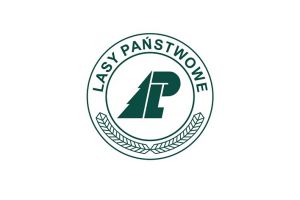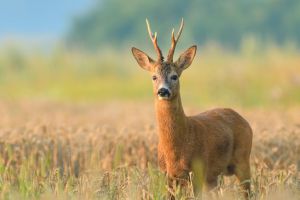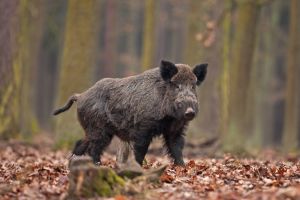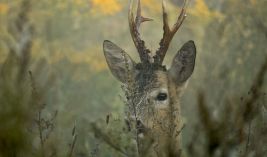Roebuck Hunt in Lutowko
Good chance of a big trophy. Varied terrain with enormous meadows and wetlands. Possibility of combining with good hunting for wild boar. Read more about roebuck hunts in Poland

Highlights
- District 18,000 hectares in size
- Annual shooting quota: 105 head of roe deer – including 55 bucks
- Most bucks are between 250-350 grams, a few over 400 grams
- Fine accommodation in the district
3 days from €950
Roebuck hunting in Poland has become a wonderful tradition amongst rifle hunters. The season starts in the spring - on May 11th -, and continues right up to the end of September. In other words it is possible to enjoy both hunting earlier in the spring as well as an exciting, traditional rut hunt in July/August, when it is possible to callup the bucks. If you are a true roebuck enthusiast, you really should not miss any of these highlights!
The population of roe deer in Poland is, thanks to longstanding strict game management policies, both very large and very dense. Year after year this wealth of game brings hunters from all over north western Europe to the vast Polish hunting districts to try their luck.
We can offer a wide range of the very best State Forest Districts in western Poland, all of which can deliver top quality roebuck hunts. The Polish districts can offer trophies of different sizes, leaving you free to choose whether you would prefer to hunt for a number of smaller bucks or go for a single, really good, trophy. These State Forest Districts all have well trained, experienced and very responsible hunting guides, who each have their own areas in the districts, which they know like the back of their own hands.
The hunt usually takes the form of stalking or lying in wait on one of the towers that have been optimally placed in each district, with regard to the deer’s behavioural patterns. You will go out hunting twice a day, once in the early morning starting before dawn, and again in the late afternoon/evening during the hours around sunset.
No matter which season you have chosen to go roebuck hunting, it will always be possible to combine your hunt with hunting for wild boar, again early in the morning and in the late evening, which are the periods the boars are most active.
We are able to offer fixed price packages, on which a hunter only need to follow the advice of his guide and does not need to worry about a large extra bill if you shoot a really good trophy. It is also possible to hunt following the districts regular price list, or our graduated price list with several categories of trophy size. Simply let us know in advance how you would like to hunt, and we will trailer your trip to it your wishes exactly!
Video Gallery

-
 World Hunter episode 7 - Hunting roebuck at Lutowko in Poland during the rut (Deer hunting)
World Hunter episode 7 - Hunting roebuck at Lutowko in Poland during the rut (Deer hunting) -
 Hunting in Polen
Hunting in Polen
Accommodation

Accommodation - Lutowko
Accommodation is in a fine hunting cottage in the district. The guest accommodation is on the first floor and consists of 2 double rooms, one three bedded room and 2 four bedded rooms, which all have their own bathroom and toilet. The gamekeeper here is Grzegorz Gorm speaks good English. There is access to a lockable garage and cold store. WiFi and mobile phone coverage are available. The...
Read moreHunting Area

Lutowko
The Lutowko state hunting is 18,000 ha. in size, of which 9,000 ha. is forest, and the remaining 9,000 ha. is mainly farmland, with some meadow, lakes and wetland. The forest is largely coniferous (60%), but there are also area of oak, birch and other broad leafed trees. The district is largely flat. Lutowko has 35 high seats/stands together with 22 feeding places. It is also possible to carry...
Read morePartner

RDLP Torun
We have worked together with the Regional Direction of State Forests in Torun –the Regionalna Dyrekcja Lasów Panstwowych we Toruniu, or in everyday language the RDLP Torun – for the last 21 years, and before that Wilson Jagtrejser (which later became Diana) worked together with some of the districts. Our partnership includes 8 state forest districts, and we have long...
Read moreHunting stories
Jens Ulrik in Poland
Darz bór!
In the beautiful fall of Northern Europe, it is time to manage the roe deer population. In the hunting area Maniszewo alone they cull 170-200 roe does and fawns during every season. Follow Jens on a hunt for field dwelling roe deer in huge Polish fields October 2013.
One by one, the bagged deer were weighed and tagged while their weight and gender was carefully noted. We were two hunters who had been hunting for three days and when everything was accounted for, there was 286 kg’s of fine venison in cold storage destined for dinner plates all over Europe. Between us, we had managed to bag slightly less than 15% of the annual quota of the entire area.
Are you coming?
The opportunity to go to Poland had suddenly materialized out of thin air a little more than week earlier. The hunting area Maniszewo in Northwestern Poland was looking for hunters interested in roe deer culling on very short notice. That type of hunting is always a challenge and furthermore it is very inexpensive. The fact that we were welcome to take some of the fine meat home with us just added to the attraction. Not surprisingly, my good friend Eric and I proved easy to persuade.
Furthermore, I was going on a big trip to Africa a few weeks later and I really wanted to try out my brand new rifle kit consisting of a Mauser M03 with a Zeiss Victory HT 2.5-10x50 on top. This was the perfect opportunity.
I picked up the rifle and scope the day before we headed for the hunt in Poland. Upon our arrival, we had a little less than an hour before we would head out on the first outing with our guides.
We were in luck! Behind the huge fenced garden of the guesthouse, there was a fine little 100 meter shooting range equipped with a homemade but very sturdy shooting bench. I quickly assembled the brand new rifle – it only took a few seconds – and I made a couple of crude paper targets with a ball pen on the back of some tax return slips from the bottom of the trunk. I knew that the gun makers at the Mauser factory had test-fired the rifle but I did not have a clue what ammunition they had used. I just hoped that the first shot with the Norma Oryx ammunition I had chosen for this hunt would land somewhere on the target so that I could start zeroing the scope properly.
Spot on!
With the rifle resting on my cap, I squeezed off the first shot. I clearly saw that the center of the reticle was comfortably within the blue ink dot as the shot rang out. I immediately took a close look at the target. Through this scope, I would easily be able to see any holes in the white paper but I found none.
We walked to the targets expecting anything. However, as we got closer a logical explanation became obvious. The bullet had punched a nice little hole in the small blue bull’s-eye exactly in the position of the crosshairs as the shot went off. Not a bad start at all! I went back and fired another shot. It also had the courtesy to land where I was aiming and thus I finished the fastest zeroing process I had ever experienced. Sometimes you simply get lucky – today it was my turn!
I matched the proper ballistic ring on the ASV+ ballistic turret to the flat shooting load I was using and felt as ready as I could be. Having faith in your equipment is a big part of any good hunting experience. On this particular hunt, I already trusted a scoped rifle that I had only fired twice!
Oceans of rapeseed
Half an hour later, I was sitting beside Zbigniew Jania in his tiny Suzuki 4WD on our way to the hunt. The hunting area of almost 18,000 hectares was divided in five subdivisions with a dedicated guide on each. Zbigniew’s area mainly consisted of big fields and to make things worse most of these fields were newly sown, black and barren. Therefore we were also allowed to hunt in one of the other subdivisions where the fields were greener and more attractive to the deer but even larger than in my guides main area. Several of these vast green oceans in the landscape were between 100 and 200 hectares from “coast to coast” without any form of natural cover.
I gazed at the scenery through the foggy window and thought that it would not be easy to get within shooting range of the roes in this wide-open terrain. My fears proved to be very real. Plenty of roe deer in small family groups filled the fields but they constantly fled in panic several hundred meters in front of the vehicle.
My guide stopped the engine at the end of a never-ending hedge stretching hundreds of meters in front of us only to disappear behind a low hill. The enormous field was harvested but there were plenty of green weeds scattered in tuffs all over the place. 500 meters away two roebucks were staring at us. Behind them, there was a roe doe and two fawns browsing. There was absolutely no chance of getting in range of these animals but my experienced guide had another simple plan. Slowly and with the wind in our faces, we would walk along the hedge up the hill. With a little luck, we would surprise some deer on the other side of the hilltop at more reasonable distances.
Far out
We mowed cautiously forward. The bucks we had seen when we started our stalk intensely followed every step we took. We approached the hilltop. Suddenly Zbigniew froze and raised his binoculars. On the other side of the hill, numerous little groups of deer were browsing the field!
I moved behind him and followed him in a smooth silent gait towards the top. He often stopped to look at the animals for a long time before slowly moving on. On the top, he put his three-legged shooting sticks up and used them to steady his binoculars. The nearest group of deer was foraging quite a bit in front of us. It was a doe with two fawns and a young doe from last year.
The disappointment in my guide’s voice was clear. “They are too far away”, he said.
”How far?” I asked silently blaming myself for not having a rangefinder with me.
His reply fell withour hesitation in the tone of voice you would expect from a man who has laid eyes on tens of thousands of roe deer through the years. “250 meters!” I lifted the ASV+ turret on the riflescope and turned it to the clear line between the 200 and 300 meter markings.
Zbigniew saw my move and understood immediately. Without uttering a word, he took a long step to the side to allow me free access to the shooting sticks. I placed the forearm in the fork of the sticks, turned the magnification to 10X and cocked the rifle. Zbigniew was staring at the deer seemingly very keen not to miss the show that was about to unfold before his eyes.
Moment of truth
”The right one!” he said to let me know that we were trying to bag the young doe. Less than a second later, the blast of the muzzle rolled over the landscape. Within the time it takes to blink, we got the sound of the bullet impact in return. It sounded like a distant but heavy blow to a large drum. The deer was knocked to the ground. It got up, while the others took flight, but it fell over immediately and never got on its feet again.
A loud and spontaneous ”WOW!” was Zbigniew’s only comment. I turned towards him and was greeted by a wide smile. Roe deer was running wild all over the field and we both saw a single doe crossing the field behind us at full speed. Zbigniew quickly moved the sticks and said ”shoot if you get the chance!”. I had dialed the ASV+ turret back to 170 meters and thus I was ready for any distance between 150 and 200 meters.
I followed the jumping roe through the scope. Just a few seconds before it reached the salvation of the hedge it made the fatal mistake that seems imbedded deeply in the genes of roe deer. It stopped to orientate. The firing pin fell instantly – and so did the deer. The distance was approximately 180 meters. I was more than satisfied. The first two shots at game with the new rifle had resulted in to fine roe does. They fell less than 20 seconds apart and yet at a distance between them of nearly half a kilometer.
The guide went to pick up the car while I went to wait by the nearest deer.
The last bite
Zbigniew was there in a few minutes and he started the mandatory ceremony to honor the killed animal at once. He picked a bundle of short rapeseed twigs and placed most of them in the mouth of the roe as a last bite before its final journey to the eternal rapeseed fields. He gently dipped the remaining two twigs in the blood of the entrance wound, placed one on top of the bullet hole and presented me with the other carefully placed on his own hat. As I took it, he gave me a firm handshake and said “Darz Bór!” – an old Polish greeting between hunters. I replied using the same words and carefully placed the little twig with the heartblood of my quarry in my hat. It is a beautiful tradition and to Zbigniew there were no exceptions – all the game we killed was honored with the same heartfelt respect.
We arranged the two animals for a photograph and in a matter of a few minutes, they were gralloched and loaded on the back of the car.
During the following days I had the good fortune to bag another eight of these shy Polish roe deer. The average shooting distance was in the area of 175 meters while a few were shot at as much as 250 meters. In total, I now have 12 empty spaces in my first box of ammo for this rifle. I am fairly content with the statistics so far considering I used two shots on paper. I choose to believe that the thousands of shots I have fired on paper targets during the past few decades have somehow improved my luck.
Grand finale
When we ended the hunt after three short days, we arranged all the deer for a photo on the lawn in front of the hunting house. As a final ceremony, our guides played the horn signals for “roe deer” and “Darz Bór” over the dead animals. The trophies of this remarkable three-day adventure were plentiful. First and foremost there is the happy memories of the hunt and the nice trip in the company of a good friend. However, the nice photos and not least the fantastic roe deer venison that hibernates in my deep freezer are also great trophies indeed.
When I raise my glass at our dinner table to toast “Darz Bór!” in the months to come my thoughts will fly to enormous Polish fields filled with light-footed roe deer, salty guides and a rifle I could blindly trust…
Game

Buck/Roe Buck/Roe Deer (Europe)
Scientific Name: Capreolus capreolus Subspecies: We have not included any of the subspecies of Capreolus capreolus, as the authors dissagree about their status as individual subspecies. Distribution: All of Europe except Ireland, Iceland, Southern Spain and Greece. Roe Deer populations are not common to the Mediterranean islands. Habitat: Roe Deer populations are found today in most terrain...
Read moreGame that may be purchased additionally

Wild Boar (Europe)
Scientific Name: Sus scrofa Subspecies: Sus sr. castilianus (Portugal and Spain) Sus sr. reiseri (Albania, Bulgaria and the former Yugoslavia). Sus sr. attila (Hungary, Romania and Russia). Distribution: All countries in Europe with the exception of The British Isles, southern Italy and southern Greece. Habitat: Woodland with dense undergrowth, often in the vicinity of pasture...
Read moreGeneral Conditions for Poland 2020/21
Single Room Supplement
Unless agreed otherwise all accommodation is in double- or 3/4-bedded rooms. A supplement for single room will be charged for, if:
• you travel alone
• a group has an uneven number of persons
• you are given a single room in the accommodation - REGARDLESS of the reason.
• you sleep alone in a room with more beds
• you book a single room
Transport during the hunt
For most hunting districts a fixed price for transport during the hunt has been agreed. The price is per hunter, regardless if you are provided with an “individual” vehicle or not. The prices vary from Euro 40 – 60 per hunter per day.
The hunt
In Poland all hunting is on 1:1 basis – so that each hunter has his own hunting guide. The Polish hunting guide is responsible for choosing the game to be shot, but it is always the guest hunter who – after having been given the permission to shoot - decides if he/she wants to shoot or not. The hunting guide always does his best to
comply with the wishes of the hunter, but it is always the person behind the rifle who takes the final decision.
Extra days hunting
If you wish to extend your stay by one or more days, this should be arranged with your interpreter or us during your stay. In some cases an extension may not be
possible.
Interruption of hunting
If, for any reason, you leave the hunting district early, there will NOT be any reimbursement to clients for any planned activities that have been booked but not carried out.
Extra meals
A lengthened stay including a single meal will be charged at Euro 22.-. A lengthened stay that includes 2 meals will be charged at the rate for a full extra day’s
accommodation.
Dogs
If you bring your own dog you will be charged a sum of Euro 10,- per day, which will normally be payable directly to the hunting district. Please be aware that not all hunting districts will accept clients bringing their own dogs. To enter Poland a dog must have a valid dog passport and be able to be identified with a readable ear tattoo or microchip.
Interpreter
An interpreter is obligatory for all hunting districts. Please inform us in advance whether you would prefer an English or German speaking interpreter. In some districts the interpreter = hunt manager or hunting guide.
Agreements
Agreements between DIANA’s clients and staff/forester in the districts will not be accepted under any circumstances. Any hunting guest is responsible for his signed protocol - regardless of ”private” agreements - verbal or written.
Trophy Deposit
When you confirm your booking of one of our hunts, we will request a trophy fee deposit. On your return home this amount will be adjusted to reflect the actual results
of your hunt. The deposits are as follows:
Red stag: Euro 1.100,-
Roebuck: Euro 200,-
Fallow buck: Euro 400,-
Wild boar: Euro 200,-
Mouflon: Euro 800,-
Driven/small driven hunts Euro 410,-
Game shot out of season
The Polish authorities have introduced a
system of charges for game shot during the
close season. The charges are as follows:
Red deer: 5,800- zloty
+ 2,000- zloty for trophies up to 5,5kg
+ 7,000 zloty for trophies over 5.5kg
Fallow deer: 2,300- zloty
+ 1,500- zloty for trophies up to 2,6kg
+ 3,000 zloty for trophies over 2.6kg
Sika deer: 5,500 zloty
+ 1,000 zloty for trophies up to 2.0kg
+ 2,500 zloty for trophies over 2.0kg
Roe deer: 2,000 zloty
+ 1,000 zloty for trophies up to 430g
+ 5,000 zloty for trophies over 430g
Mouflon: 1,800 zloty
Wild Boar: 2,300 zloty
Other species: 1,000 zloty
Game shot within the hunting season but without permission of the hunting leader has to be paid according to the trophy price list + a punishment of 100%.
Protocols
We advice all hunters to oversee the weighing and measurement of trophies before signing the hunting protocol – regardless of which package you bought. If a hunter wishes to bring home the whole head of a game animal, its weight will be set in the hunting district. The cost will then be calculated from that weight. We therefore
can NOT recognise any claims arising from this. This also applies to the measurement of wild boar tusks. If a hunter wishes to bring home the whole head, the tusks
will be measured with the visible part being assumed to make up 1/3 of the total length. Trophies are normally weighed and measured 24 hours after boiling. If a hunter
leaves the district earlier than 24 hours after the trophy was boiled, it will be the wet weight that will be entered on the protocol and it will not be possible afterwards to
claim any refund on the price charged – regardless of circumstances. If you, for any reason, have cause to lodge a complaint or request a refund, this HAS TO be done in the protocol or it will not be possible for us to handle your case after you return home. Please note that when you sign the protocol you confirm that everything stated within it is 100% correct.
Settling of your final account
The settling of your final account will take place after we has received the hunting protocol from Poland, which can take 4-6 weeks, regardless if monies will be refunded
or an extra charge made. An extra invoice has to be paid within 10 days, also if you by any reason have decided to leave the trophy and/or skins etc. in the district for later pick up or posting. Please be aware that sick or previously wounded game shot by the guest hunter and entered into the protocol has to be paid according to the usual price lists.
Alcohol
It has been determined by law that all hunts are to be reported to the police not later than 7 days before the beginning of the hunt - stating the exact dates for the hunt
and the address of the accommodation. This means that unannounced inspections can occur. They want to check if all personal papers are okay and also if the hunters are hunting with alcohol in the blood. The blood alcohol level for driving in Poland is 0.0% and the same goes for carrying a rifle.
Choice of calibre
Polish regulations state the following ROE DEER: From 100m the bullet must have energy on impact of 1,000 joules. OTHER GAME: From 100m the bullet must have energy on impact of 2,000 joules.
Driven-/small driven hunts
Please be aware that it is only allowed to use telescopic sights of max. x3 magnification for driven and small-driven hunting. Variable sights that can be adjusted down
to x3 magnification and below are allowed. That is to say that, for example a 2.5 – 10x magnification is allowed. Sights with a fixed magnification of more than x3 are not allowed. According to the polish law each hunter HAS to wear min. 2 elements in fluorescent colours – et means yellow or orange.
Gratuities
It is normal to give a small tip to your hunting guide, to the translator and the kitchen. How much you give is up to your own discretion.
Full Moon Calendar 2020/21
10th January
09th February
09th March
08th April
07th May
05th June
05th July
03rd August
02nd September
01st October
31st October
30th November
30th December
28th January
27th February
28th March
Hunting seasons 2020/21
| Roebuck | 09.05.-30.09. |
| Roe Does/Lambs | 01.10.-17.01. |
| Red Stag | 21.08.-28.02. |
| Red Deer Hind | 01.09.-17.01. |
| Red Deer Calf | 01.09.-28.02. |
| Fallow Stag | 01.09.-28.02. |
| Fallow Deer Does and Kids | 01.09.-28.02. |
| Wild boar: Keilers, yearlings, piglets | Whole Year |
| Mouflon Rams | 01.10.-28.02. |
| Mouflon Ewes/Lambs | 01.10.-17.01. |
| Fox | 30.05.-31.03. |
| Badger | 01.09.-30.11. |
| Racoon dog | Whole Year |
| Wild Ducks | 15.08.-21.12. |
| Wild geese, West Poland | 01.09.-31.01. |
Prices

The price includes
- 3 days accommodation (kat. s) with full board
- 3 days roebuck hunting with own hunting guide (6 outings)
- All licenses and related fees
- Boiling of trophies
The price does not include
- Final settlement of shot game
- Transport during the hunt, PLN 360,- per hunter/per day
- Extra hunting day € 310,-
- Stay without hunt/non-hunter per day €165,-
- Supplement for single room per day € 25,-
- Interpreter per person/day (optional - must be ordered in advance) € 81,-
- EU-public liability insurance € 10,00 (obligatory)
- Travel insurance
- Cancellation insurance
- Tips
- Skinning € 65,-
- Skinning for shoulder mount:
Red Stag € 152,-
Fallow Stag € 122,-
Roe buck / wild boar € 92,-
Purchase of skin per kg € 16,- - Purchase of skin from fox and racoon dog € 33,-
- Searching for wounded game with dog € 130,-
- Extra outing / night hunt € 80,-
Diana Hunting Tours has partnered with the travel insurance company European (ERV) and is pleased to offer you an ideal travel insurance solution for your hunting trip, as well as cancellation insurance in case you need to cancel the trip due to illness.
Please note that this insurance offer is available only to residents of Denmark, Norway, Sweden, Iceland, Greenland, the Faroe Islands, Germany, Finland, and the Netherlands.
If you would like to purchase travel or cancellation insurance through Diana Hunting Tours, please contact your travel consultant or our support team at +45 62 20 25 40, or send an email to info@diana.dk.
Trophy Price List
All roebucks shot will be settled according to the following price-list:
Roebuck:
Up to 199 g € 215,00
200-299 g € 535,00
300-399 g € 580,00
from 400 g € 890,00
Wigged buck € 970,00
Wounding € 335,00
It will also be possible to shoot wild boars according to the following price list:
Wild Boar:
Keilers:
140 mm - 159 mm € 500,00
160 mm – 199 mm € 660,00 + € 16,75 pr. mm over 160 mm
200 mm and above € 1.330,00 + € 26,60 pr. mm over 201 mm
Keilers under 140 mm and for piglets and yearlings are charged for by weight, as follows:
Piglets, yearlings:
Up to 29,99 kg € 105,00
30-59,99 kg € 206,00
From 60 kg and up € 420,00
Wounding € 172,00
Price pr. 15/1-2025

































































